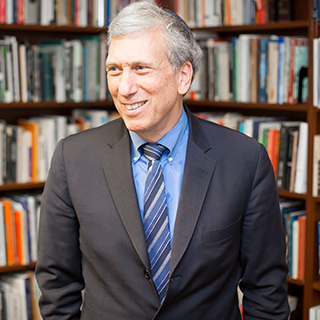Jewish-American, American-Jew: The Complexities and Joys of Living a Hyphenated Identity

Download Sources ǀ The Four Questions by Allegra Goodman
Part of the series, The Space in Between: Thresholds and Borders in Jewish Life and Thought
With Dr. Arnold Eisen, Chancellor Emeritus and Professor of Jewish Thought, JTS
The Pew Reports and many scholars use the first description of who we are; JTS (and I myself) prefer the second. It matters a great deal to a person’s identity whether “Jew” and “American” are adjective or noun; it matters still more how Jews and non-Jews understand the hyphen that links the two parts of these (and other religious and ethnic identities) one to another. We explore that “liminal space” of the self through analysis of a wide range of books, essays, films and literary characters.
Lecture Notes
The challenge of Jewish identity has been a fixture of American Jewish consciousness. In the 1920s to 1950s, there was a focus on the question of chosen-ness (Are the Jews Chosen? One of many chosen people? Just a people?) The question of adjectives-noun relationship (Jewish American, American Jew) has been an ongoing fixture—Eisen pointed to a 1919 statement from Hitler about European Jewish identity to show that this is not just a question of Jewish internal musing, but reflects questions around loyalty in a particular society
Eisen introduced 4 scholars to highlight the preservation of Jewish identity in the US:
- Mordechai Kaplan: In a country like the US, Jews live in 2 civilizations (Jewish and American) and Judaism must be a maximalist identity in competition with prevailing American culture in order to maintain its distinctiveness
- Eugene Borowitz (Reform): Jewish identity is primary, but life in the US or the broader human condition is the framework for which Jewish life is lived
- Abraham Joshua Heschel: Jewish identity is lived within the culture of the prevailing civilization, but must preserve Jewish authenticity in religious and cultural terms. Eisen described this as a communication between Judaism and Jew, which should be primary in the defining the relationship
- Joseph Soloveitchik (Orthodox): Everyone has Adam I (driven by needs, societal wants/structures) and Adam II (driven by loves, beliefs, ethical questions, social contracts) within themselves. Soleveitchik noted that in the US Adam I seems to take priority. He saw this internal battle as a battle between culture and faith
He reflected that in 21st Century America, the question and identities are different, noting how race, gender, multiple nationalities, and personal identities are part of the larger equation.
The question of Jewish identity an Israel, which was noted in a 1930s Kaplan piece that living in Israel would not lead to a divided Jewish identity, but Eisen pointed out that Kaplan chose to live and grapple with Jewish identity in the US. The conversation around Jewish identity in Israel reflected the current political challenges and if this is creating additional barriers for younger or less connected Jews.
About the Series
We are living in an undefined time: our daily existence is no longer dominated by the pandemic, yet neither have we settled into a new normal. This sense of being in transition—neither here nor there— can feel destabilizing; but is the time in between really temporary, or are we always living in between moments, identities, and phases of life?
In this series, JTS scholars will delve into the idea of liminality—the time or space in between—which we encounter often in Jewish ritual, identity, law, and life. Join us to consider what these many manifestations of “in-between-ness” can teach us about ourselves and about Judaism, and to explore how we might find strength and meaning in an orientation not of “either/or” but of “both/and.”
We will explore themes of borders, thresholds and transitions as they pertain to the story of Creation, gender, conversion, birth and death, the duality of living as a Jew in America, and more.
SPONSOR A SESSION
This session was generously sponsored at the Navi-level by Yale Asbell, JTS Trustee and Harriet P. Schleifer in memory of her parents, Rubin and Frances Partel.
At JTS, we are committed to providing the Jewish community with outstanding classes in Judaic studies. We hope you will partner with us so that we can continue to do so. Did you know that you can sponsor a learning session to honor a loved one, celebrate an occasion, or commemorate a yahrzeit? You can find sponsorship information here.



